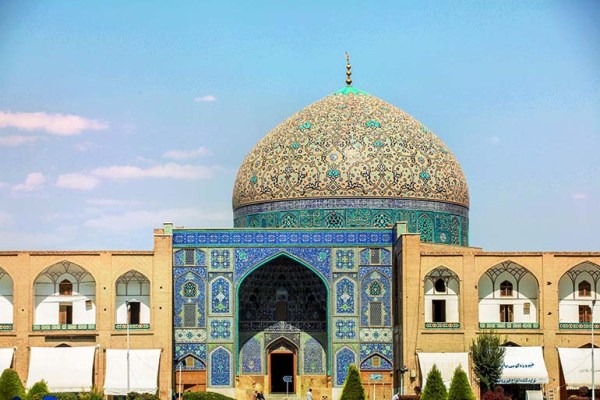
Sheikh lotfolah mosque
Sheikh Lotfollah Mosque is a unique architectural work located in Isfahan and is part of UNESCO World Heritage. This mosque was built during the Safavid period in the early 17th century AD (built in 1619-1602 AD - during the time of Shah Abbas the Great). Sheikh Lotfollah Mosque is known for its unique and complex design, making it a must-see attraction. This mosque, which is located in front of Ali Qapo Mansion and next to the Shah Mosque, is named after Sheikh Lotfollah Ameli Esfahani, one of the prominent scholars of that time. Sheikh Lotfollah Mosque is located on the eastern side of Naqsh Jahan Square, which is one of the largest squares in the world. One of the most prominent features of the Sheikh Lotfollah Mosque is its dome, which, unlike many other mosques, does not have a minaret. This building is decorated with a special tiling pattern and creates a special effect by reflecting the sunlight from the tiles. The mosaic tiles on the exterior of the mosque are very detailed and a special skill has been used in their design and construction. The walls of the mosque are covered with floral motifs and delicate calligraphy. The ceiling is made with delicate and artistic patterns. The sound reflection in Sheikh Lotfollah Mosque introduces the special architecture of this building. If you stand at a certain point on one side of the mosque, your voice can be heard clearly from the other side, even in a soft whisper. This place was built to honor Sheikh Lotfollah Maisi and attracts many tourists every year.
building
The building of the mosque is based on a quadrilateral, which is turned into an octagon in the upper part of the building, finally it joins the stem of the dome in a circle. The walls of the mosque are built for heavy luxury and the pressure of the thick dome, and they make it so that it reaches one meter and seventy centimeters from the window parts and more than two meters in the main parts.
The motifs and colors used in the tile work of Ostadan Gonbad are among the most beautiful tile works in Iranian architecture. The numbers of the mosaic tiles inside and outside the dome and the books of its third calligraphy are Alireza Tabrizi Abbasi's handwriting.
This mosque is not similar to other mosques because it does not have a minaret, nor does it have an entrance to the courtyard (courtyard), and the entrance has stairs. The absence of a nave and an entrance court, this mosque is subject to the symmetry requirements of Naqsh Jahan Square (the mosque is located facing the Ali Qapo mansion), which has ultimately led to the problem that a court or courtyard facing the front of the prayer hall cannot be used for it. designed
The architectural style of this building is Isfahani style. Jalo Khan Mosque begins by retreating from the eastern body of the square. After passing through four stairs, we reach the main area. The lower part of the walls of this area is covered with yellow marble, the big side platforms are also of the same type of stone. The entrance of the mosque is in the form of two panels, which are made of plantain wood and are still standing after four hundred years. In front of the mosque, there is a beautiful octagonal pool, which was removed in 1316-1318. In this cover, the dome floor is made of plaster and the wooden windows installed in it illuminate the basement. Sheikh Lotfollah Mosque has no yard.

